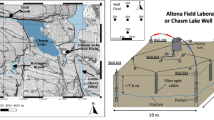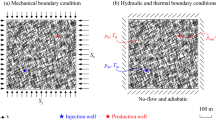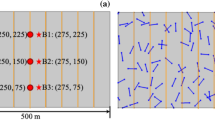Abstract
We investigate the flow-channeling phenomenon caused by thermal drawdown in fractured geothermal reservoirs. A discrete fracture network-based, fully coupled thermal–hydrological–mechanical simulator is used to study the interactions between fluid flow, temperature change, and the associated rock deformation. The responses of a number of randomly generated 2D fracture networks that represent a variety of reservoir characteristics are simulated with various injection-production well distances. We find that flow channeling, namely flow concentration in cooled zones, is the inevitable fate of all the scenarios evaluated. We also identify a secondary geomechanical mechanism caused by the anisotropy in thermal stress that counteracts the primary mechanism of flow channeling. This new mechanism tends, to some extent, to result in a more diffuse flow distribution, although it is generally not strong enough to completely reverse flow channeling. We find that fracture intensity substantially affects the overall hydraulic impedance of the reservoir but increasing fracture intensity generally does not improve heat production performance. Increasing the injection-production well separation appears to be an effective means to prolong the production life of a reservoir.



























Similar content being viewed by others
References
Auradou H, Drazer G, Boschan A, Hulin J-P, Koplik J (2006) Flow channeling in a single fracture induced by shear displacement. Geothermics 35:576–588
Bandis S, Lumsden A, Barton N (1983) Fundamentals of rock joint deformation. Int J Rock Mech Min Sci Geomech Abstr 20:249–268
Barton N, Bandis S, Bakhtar K (1985) Strength deformation and conductivity coupling of rock joints. Int J Rock Mech Min Sci Geomech Abstr 22:121–140
Berkowitz B, Ewing R (1998) Percolation theory and network modeling applications in soil physics. Surv Geophys 19:23–72
Bödvarsson GS, Tsang CF (1982) Injection and thermal breakthrough in fractured geothermal reservoirs. J Geophys Res 87:1031–1048
Botros FE, Hassan AE, Reeves DM, Pohll G (2008) On mapping fracture networks onto continuum. Water Resour Res 44:W08435
Bower K, Zyvoloski G (1997) A numerical model for thermo-hydro-mechanical coupling in fractured rock. Int J Rock Mech Min Sci Geomech Abstr 34:1201–1211
Bruel D (2002) Impact of induced thermal stresses during circulation tests in an engineered fractured geothermal reservoir. Oil Gas Sci Technol 57:459–470
Cook NGW (1992) Natural joints in rock: mechanical, hydraulic and seismic behaviour and properties under normal stress. Int J Rock Mech Min Sci Geomech Abstr 29:198–223
Cook RD, Malkus DS, Plesha ME, Witt RJ (2001) Concepts and applications of finite element analysis. Wiley, New York
Dershowitz WS, Einstein HH (1988) Characterizing rock joint geometry with joint system models. Rock Mech Rock Eng 21:21–51
DuTeaux R, Swenson D, Hardeman B (1996) Insight from modelling discrete fractures using GEOCRACK. In: Proceedings of the 21st Workshop on Geothermal Reservoir Engineering, SGP-TR-151, Stanford CA, pp 287–293
Engelder T, Lash GG, Uzcátegui RS (2009) Joint sets that enhance production from Middle and Upper Devonian gas shales of the Appalachian Basin. Am Assoc Pet Geol Bull 93:857–889
Fu P, Carrigan CR (2012) Modeling responses of naturally fractured geothermal reservoir to low-pressure stimulation. In: Proceedings of the 36th Annual Meeting of Geothermal Resources Council, Reno NV
Fu P, Johnson SM, Carrigan CR (2012) Using explicitly coupled hydro-geomechanical test bed to study hydraulic reservoir stimulation with low pressure. In: Proceedings of the 37th Stanford Geothermal Workshop, Stanford CA
Fu P, Johnson SM, Carrigan CR (2013) An explicitly coupled hydro-geomechanical model for simulating hydraulic fracturing in arbitrary discrete fracture networks. Int J Numer Anal Meth Geomech 37(14):2278–2300
Genter A, Cuenot N, Goerke X, Melchert B, Sanjuan B, Scheibert J (2012) Status of the Soultz geothermal project during exploitation between 2010 and 2012. In: Proceedings of the 37th Workshop on Geothermal Reservoir Engineering, Stanford CA, SGP–TR–194
Genter A, Cuenot N, Melchert B, Moeckes W, Ravier G, Sanjuan B, Sanjuan R, Scheiber J, Schill E, Schmittbuhl J (2013) Main achievements from the multi-well EGS Soultz project during geothermal exploitation from 2010 and 2012. European Geothermal Congress 2013, Pisa Italy
Ghassemi A, Tarasovs S, Cheng AHD (2007) A 3-D study of the effects of thermomechanical loads on fracture slip in enhanced geothermal reservoirs. Int J Rock Mech Min Sci 44:1132–1148
Hao Y, Fu P, Johnson SM, Carrigan CR (2012) Numerical studies of coupled flow and heat transfer processes in hydraulically fractured geothermal reservoirs. In: Proceedings of the 36th Annual Meeting of Geothermal Resources Council Reno NV
Hao Y, Fu P, Carrigan CR (2013) Application of a dual-continuum model for simulation of fluid flow and heat transfer in fractured geothermal reservoirs. In: Proceedings of the 38th Stanford Geothermal Workshop, Stanford CA
Hart RD, St. John CM (1986) Formulation of a fully-coupled thermal-mechanical-fluid flow model for non-linear geologic systems. Int J Rock Mech Min Sci Geomech Abstr 23:213–224
Hicks TW, Pine RJ, Willis-Richards J, Xu S, Jupe AJ, Rodrigues NEV (1996) A hydro-thermo-mechanical numerical model for HDR geothermal reservoir evaluation. Int J Rock Mech Min Sci Geomech Abstr 33:499–511
Hogarth RA, Bour D (2015) Flow performance of the Habanero EGS closed loop. In: Proceedings of World Geothermal Congress 2015, Melbourne, Australia, 19–25 Apr 2015
Jung R (2013) EGS-Goodbye or back to the future. In: Bunger AP, McLennan J, Jeffrey R (eds) Effective and sustainable hydraulic fracturing. InTech, pp 95–121
Koh J, Roshan H, Rahman SS (2011) A numerical study on the long term thermo-poroelastic effects of cold water injection into naturally fractured geothermal reservoirs. Comput Geotech 38:669–682
Kohl T, Evansi K, Hopkirk R, Rybach L (1995) Coupled hydraulic thermal and mechanical considerations for the simulation of hot dry rock reservoirs. Geothermics 24:345–359
Kresse O, Weng X, Gu H, Wu R (2013) Numerical modeling of hydraulic fractures interaction in complex naturally fractured formations. Rock Mech Rock Eng 46:555–568
McClure MW, Horne RN (2014) An investigation of stimulation mechanisms in enhanced geothermal systems. Int J Rock Mech Min Sci 72:242–260
Mindlin R, Cooper H (1950) Thermoelastic stress around a cylindrical inclusion of elliptic cross-section. J Appl Mech Trans ASME 17:265–268
Nicol D, Robinson B (1990) Modelling the heat extraction from the Rosemanowes HDR reservoir. Geothermics 19:247–257
Nitao JJ (1998) Reference manual for the NUFT flow and transport code version 2.0. Lawrence Livermore National Laboratory, Livermore CA
O’Sullivan MJ, Pruess K, Lippmann MJ (2001) State of the art of geothermal reservoir simulation. Geothermics 30:395–429
Reeves DM, Benson DA, Meerschaert MM (2008) Transport of conservative solutes in simulated fracture networks: 1 synthetic data generation. Water Resour Res 44:W05404
Rutqvist J, Wu YS, Tsang CF, Bodvarsson G (2002) A modeling approach for analysis of coupled multiphase fluid flow heat transfer and deformation in fractured porous rock. Int J Rock Mech Min Sci 39:429–442
Settgast RR, Johnson SM, Walsh SDC, Fu P, Ryerson FJ (2012) Simulation of hydraulic fracture networks in three-dimensions. In: Proceedings of the 37th Stanford Geothermal Workshop, Stanford CA
Taron J, Elsworth D (2009) Thermal–hydrologic–mechanical–chemical processes in the evolution of engineered geothermal reservoirs. Int J Rock Mech Min Sci 46:855–864
Taron J, Elsworth D, Min KB (2009) Numerical simulation of thermal-hydrologic-mechanical-chemical processes in deformable fractured porous media. Int J Rock Mech Min Sci 46:842–854
Tsang C, Neretnieks I (1998) Flow channeling in heterogeneous fractured rocks. Rev Geophys 36:275–298
Tsang YW, Tsang CF (1987) Channel model of flow through fractured media. Water Resour Res 23:467–479
Willis-Richards J, Watanabe K, Takahashi H (1996) Progress toward a stochastic rock mechanics model of engineered geothermal systems. J Geophys Res 101:17481–17496
Acknowledgments
The authors gratefully acknowledge the Geothermal Technologies Office of the US Department of Energy for support of this work. Additional support was provided by the LLNL LDRD project “Creating Optimal Fracture Networks” (#11-SI-006). An anonymous editor of the journal provided valuable advice that substantially improved the quality of this paper, for which the authors are especially grateful. This work was performed under the auspices of the US Department of Energy by Lawrence Livermore National Laboratory under Contract DE-AC52-07NA27344. This paper is LLNL report LLNL-JRNL-644453.
Author information
Authors and Affiliations
Corresponding author
Rights and permissions
About this article
Cite this article
Fu, P., Hao, Y., Walsh, S.D.C. et al. Thermal Drawdown-Induced Flow Channeling in Fractured Geothermal Reservoirs. Rock Mech Rock Eng 49, 1001–1024 (2016). https://doi.org/10.1007/s00603-015-0776-0
Received:
Accepted:
Published:
Issue Date:
DOI: https://doi.org/10.1007/s00603-015-0776-0




